Oxidation numbers - Study guides, Revision notes & Summaries
Looking for the best study guides, study notes and summaries about Oxidation numbers? On this page you'll find 805 study documents about Oxidation numbers.
Page 2 out of 805 results
Sort by
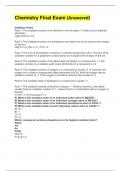
-
Chemistry Final Exam (Answered)
- Exam (elaborations) • 34 pages • 2023
-
- £11.04
- + learn more
Chemistry Final Exam (Answered) Oxidation Rules Rule 1: The oxidation number of an element in its free state = 0 (Also true for diatomic elements) -Mg=0,H2=0, C=0 Rule 2: The oxidation number of a monatomic (one-atom) ion is the same as the charge on the ion -Mg^2+=+2, Na^+=+1, O^2-=-2 Rule 3: The sum of all oxidation numbers in a neutral compound is zero. The sum of all oxidation numbers in a polyatomic (many-atom) ion is equal to the charge on the ion. Rule 4: The oxidation numb...
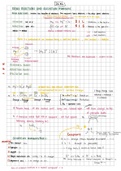
-
IEB Physical Sciences: paper 2 Chemistry- electrochemistry summary
- Summary • 17 pages • 2022
- Available in package deal
-
- £3.63
- 3x sold
- + learn more
IEB Physical Sciences: paper 2 Chemistry- Electrochemistry for help in understanding the IEB electrochemistry depth notes ,summaries and diagrams on : Redox reactions and oxidation numbers,galvanic cells, electrolytic cells, standard hydrogen half cells, application of such and standard electrode potentials aswell as electrolysis application in aluminium extraction and the chlor-alkali industry and quantitative calculations based on electrolytic and galvanic cells
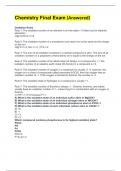
-
Chemistry Final Exam (Answered)
- Exam (elaborations) • 34 pages • 2023
-
- £10.22
- + learn more
Chemistry Final Exam (Answered) Oxidation Rules Rule 1: The oxidation number of an element in its free state = 0 (Also true for diatomic elements) -Mg=0,H2=0, C=0 Rule 2: The oxidation number of a monatomic (one-atom) ion is the same as the charge on the ion -Mg^2+=+2, Na^+=+1, O^2-=-2 Rule 3: The sum of all oxidation numbers in a neutral compound is zero. The sum of all oxidation numbers in a polyatomic (many-atom) ion is equal to the charge on the ion. Rule 4: The oxidation numb...
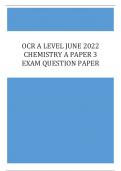
-
OCR A LEVEL JUNE 2022 CHEMISTRY A PAPER 3 EXAM QUESTION PAPER
- Exam (elaborations) • 22 pages • 2024
-
- £10.63
- + learn more
OCR A LEVEL JUNE 2022 CHEMISTRY A PAPER 3 EXAM QUESTION PAPERThese questions are from different areas of chemistry. (a) Ammonia, NH3, and ammonium nitrate, NH4NO3, are compounds of nitrogen. (i) The boiling point of NH3 is –33 °C. The boiling point of NH4NO3 is 210 °C. Explain why there is a large difference in boiling points. ........................................................................................................................................... ........................
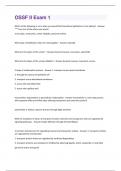
-
OSSF II Exam 1 Questions and Answers(A+ Solution guide)
- Exam (elaborations) • 36 pages • 2024
- Available in package deal
-
- £6.54
- + learn more
Which of the following is not a place you would find transitional epithelium in the kidney? - Answer- *** here are all the places you would renal calyx, renal pelvis, ureter, bladder, proximal urethra What type of epitihelium lines the renal papilla? - Answer-cuboidal What are the layers of the ureter? - Answer-(lumen) mucosa, muscularis, adventitia What are the layers of the urinary bladder? - Answer-(lumen) mucosa, muscularis, serosa 5 steps of reabsorption process - Answer-1. transport ...
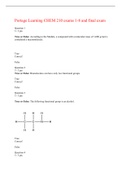
-
PORTAGE LEARNING CHEM 210 exams 1-8 and final exam
- Exam (elaborations) • 124 pages • 2023
-
- £23.72
- 5x sold
- + learn more
Portage Learning CHEM 210 exams 1-8 and final exam Question 1 3 / 3 pts True or False: According to the Module, a compound with a molecular mass of 1,000 g/mol is considered a macromolecule. True Correct! False Question 2 3 / 3 pts True or False: Biomolecules can have only two functional groups. True Correct! False Question 3 3 / 3 pts True or False: The following functional group is an alcohol. True Correct! False Question 4 3 / 3 pts True or False: In ...
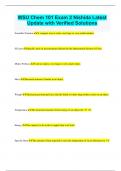
-
WSU Chem 101 Exam 2 Nishida Latest Update with Verified Solutions
- Exam (elaborations) • 8 pages • 2024
- Available in package deal
-
- £8.17
- + learn more
WSU Chem 101 Exam 2 Nishida Latest Update with Verified Solutions Scientific Notation A compact way to write very large or very small numbers SI Units Specific units of measurements defined by the International System of Units Metric Prefixes Used to express very large or very small values Mass Measured amount of matter in an object Weight Measured gravitational force that the Earth (or other large bodies) exert on an object Temperature The measured amount of heat energy in an...
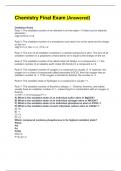
-
Chemistry Final Exam (Answered)
- Exam (elaborations) • 34 pages • 2023
-
- £10.22
- + learn more
Chemistry Final Exam (Answered) Oxidation Rules Rule 1: The oxidation number of an element in its free state = 0 (Also true for diatomic elements) -Mg=0,H2=0, C=0 Rule 2: The oxidation number of a monatomic (one-atom) ion is the same as the charge on the ion -Mg^2+=+2, Na^+=+1, O^2-=-2 Rule 3: The sum of all oxidation numbers in a neutral compound is zero. The sum of all oxidation numbers in a polyatomic (many-atom) ion is equal to the charge on the ion. Rule 4: The oxidation numb...
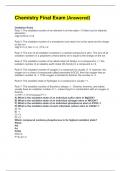
-
Chemistry Final Exam (Answered)
- Exam (elaborations) • 34 pages • 2023
-
- £11.85
- + learn more
Chemistry Final Exam (Answered) Oxidation Rules Rule 1: The oxidation number of an element in its free state = 0 (Also true for diatomic elements) -Mg=0,H2=0, C=0 Rule 2: The oxidation number of a monatomic (one-atom) ion is the same as the charge on the ion -Mg^2+=+2, Na^+=+1, O^2-=-2 Rule 3: The sum of all oxidation numbers in a neutral compound is zero. The sum of all oxidation numbers in a polyatomic (many-atom) ion is equal to the charge on the ion. Rule 4: The oxidation numb...
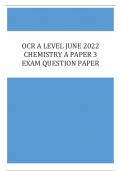
-
OCR A LEVEL JUNE 2022 CHEMISTRY A PAPER 3 EXAM QUESTION PAPER
- Exam (elaborations) • 22 pages • 2024
-
- £10.63
- + learn more
OCR A LEVEL JUNE 2022 CHEMISTRY A PAPER 3 EXAM QUESTION PAPERThese questions are from different areas of chemistry. (a) Ammonia, NH3, and ammonium nitrate, NH4NO3, are compounds of nitrogen. (i) The boiling point of NH3 is –33 °C. The boiling point of NH4NO3 is 210 °C. Explain why there is a large difference in boiling points. ........................................................................................................................................... ........................

Study stress? For sellers on Stuvia, these are actually golden times. KA-CHING! Earn from your revision notes too and start uploading now. Discover all about earning on Stuvia


